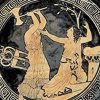Each play of the trilogy is a self-contained dramatic unit, although the endings of the first two plays lead naturally into the play that follows them. Any of the three plays can be presented alone without too much loss of understanding, but the meaning and dramatic effect of the works is enhanced by production or reading of them as a group.
Each play has its own chorus and a nearly separate cast of characters, but the trilogy is given unity by the basis of its plots in the same cycle of legends. In addition, there are certain underlying themes that continue from play to play and that reach their full resolution only at the conclusion of The Eumenides.
The main idea of The Oresteia is that injustice and such primitive instruments of morality as the blood-feud must be eliminated if human society is ever to attain to a high level of social organization, which can only be done by the introduction of a public morality and civic legal processes. A compromise must be reached between those old ideas that are good and those new ideas that are good. The city of Athens, whose patron goddess is the spirit of wisdom, is exalted as the model that people ought to emulate.
The Oresteia uses the legend of the family of Atreus as raw material for examination of different aspects of this theme: such questions as the nature of justice, methods of establishing and maintaining justice on earth, the relationship of justice to vengeance, mercy, the gods, fate, and the social order. It also deals with the related doctrines that wisdom can be learned only through experience and suffering, that one crime invariably leads to another if the criminal is not punished, that blood, once shed, can never be atoned for, and that authority is the foundation of civilization.

